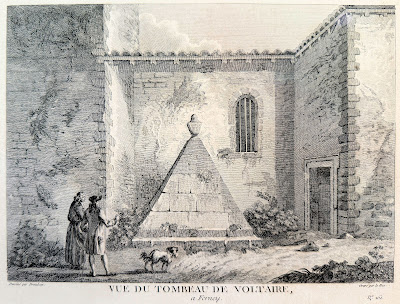Following le plat de résistance at CERN, the participants of the
Museumsgesellschaft's summer tour 2025
savored an excellent dessert by visiting the Château de Voltaire at Ferney the
following day.
When entering the château, you find the entrance door framed by statues of
the Vieux Patriarch and Jean-Jacques Rousseau. Voltaire looks
mockingly at the reading Rousseau.
Although both men were enlightened and shared some common ideals, such as critiques of the Church and traditional authorities, they had very different philosophies, temperaments, and views on society, which led to sharp personal and intellectual clashes.
Voltaire took on Rousseau after the publication of Du contrat social ou Principes du droit politique: "One longs, in reading your book, to walk on all fours."
Rousseau, in turn, regarded Voltaire as insincere, elitist, corrupted by luxury and salon society, and accused him of orchestrating a conspiracy to ridicule him.
Despite their mutual dislike, both giants of the Enlightenment profoundly influenced the French Revolution and modern democratic thinking. Voltaire, being the liberal, reformist strand, and Rousseau, the radical, populist one.
Although both men were enlightened and shared some common ideals, such as critiques of the Church and traditional authorities, they had very different philosophies, temperaments, and views on society, which led to sharp personal and intellectual clashes.
Voltaire took on Rousseau after the publication of Du contrat social ou Principes du droit politique: "One longs, in reading your book, to walk on all fours."
Rousseau, in turn, regarded Voltaire as insincere, elitist, corrupted by luxury and salon society, and accused him of orchestrating a conspiracy to ridicule him.
Despite their mutual dislike, both giants of the Enlightenment profoundly influenced the French Revolution and modern democratic thinking. Voltaire, being the liberal, reformist strand, and Rousseau, the radical, populist one.
Their disputes reflect the broad debates of the epoch between reason and
emotion, civilization and nature, elite reform and popular revolution.
Here are some photos from the exhibition at the Château:

|
| Voltaire et ses amis. The Patriarch enjoyed good company. |

|
| Henri IV accueillant Voltaire aux Champs-Elysées |

|
| Le Triomphe de Voltaire 1775 |

|
| Catherine the Great. The inscription reads:
paint à dinant par Pierre-Lyon-peintre-de Sa Majesté Limpératrice Reine J:R:A donné à M. de Voltaire, le 15 juillet 1770 |

|
| Madame Denis' bedroom, Voltaire's mistress |
The Patriarch had the building restored and erected a monumental façade bearing the inscription, "Deo erexit Voltaire MDCCLXI (Erected by Voltaire to God in 1761)." What a scandal, Voltaire's name was written with larger letters than God's.

|
| A fake inscription: This is not Voltaire's tomb. |
Voltaire was a hypochondriac all his life. As he grew older, his fear of
dying and being buried in a mass grave grew. So he decreed that when he was dying, he should be taken to
Geneva. After his death, he was to be transported back to Ferney. Thus,
rascal Voltaire wanted to die a Calvinist but be buried a Catholic.
However, things turned out differently. Following Voltaire's triumphal return to Paris at the beginning of February 1778, he died there on May 30. The Parisian clergy, as expected, opposed a church funeral. Only
through deception was Voltaire's family able to bury his body in the Abbey
of Scellières (Champagne).
During the French Revolution, Voltaire's remains were transferred to the
Pantheon. His tomb lies opposite that of Jean-Jacques Rousseau.
Finally pacified in death?
*




No comments:
Post a Comment